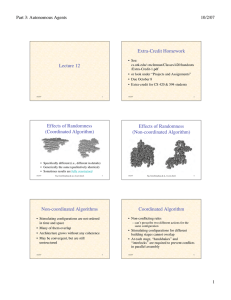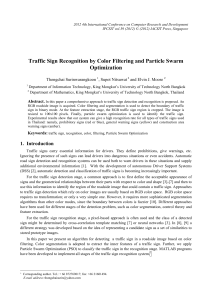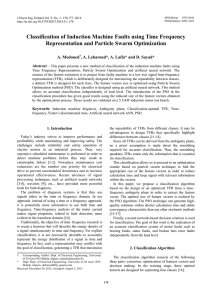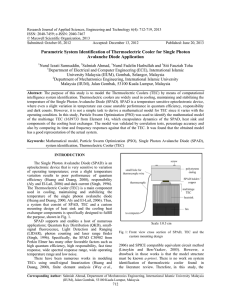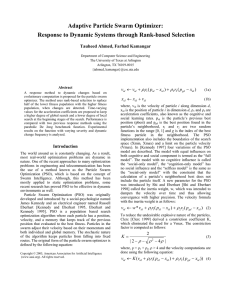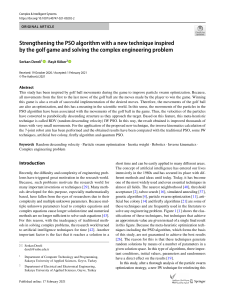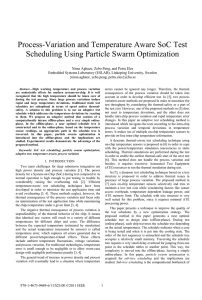Motivation Particle Swarm Optimization Part 3: Autonomous Agents 10/13/04
advertisement
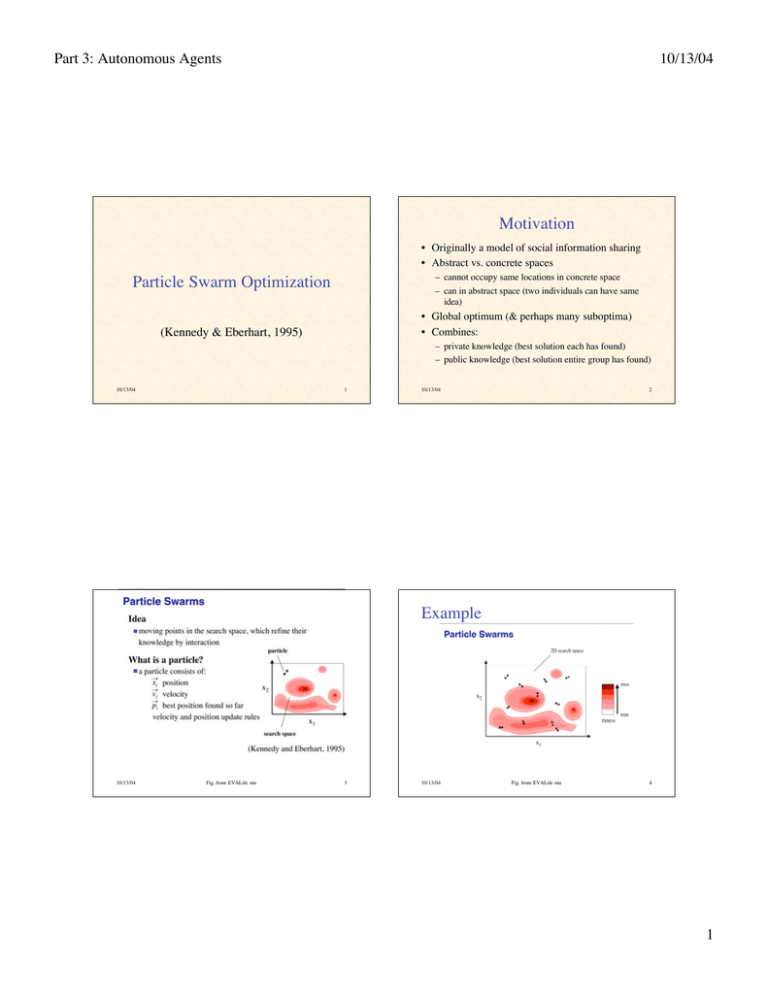
Part 3: Autonomous Agents 10/13/04 Motivation • Originally a model of social information sharing • Abstract vs. concrete spaces – cannot occupy same locations in concrete space – can in abstract space (two individuals can have same idea) Particle Swarm Optimization • Global optimum (& perhaps many suboptima) • Combines: (Kennedy & Eberhart, 1995) – private knowledge (best solution each has found) – public knowledge (best solution entire group has found) 10/13/04 1 10/13/04 2 Example 10/13/04 Fig. from EVALife site 3 10/13/04 Fig. from EVALife site 4 1 Part 3: Autonomous Agents 10/13/04 Example 10/13/04 Example Fig. from EVALife site 5 Example 10/13/04 10/13/04 Fig. from EVALife site 6 Fig. from EVALife site 8 Example Fig. from EVALife site 7 10/13/04 2 Part 3: Autonomous Agents 10/13/04 Example 10/13/04 Example Fig. from EVALife site 9 10/13/04 Example Fig. from EVALife site 10 Variables xk = current position of particle k vk = current velocity of particle k pk = best position found by particle k Q(x) = quality of position x g = index of best position found so far i.e., g = argmaxk Q(pk) 1, 2 = random variables uniformly distributed over [0, 2] w = inertia < 1 10/13/04 Fig. from EVALife site 11 10/13/04 12 3 Part 3: Autonomous Agents 10/13/04 Velocity & Position Updating Improvements vk = w vk + 1 (pk – xk) + 2 (pg – xk) • Alternative velocity update equation: vk = [w vk + 1 (pk – xk) + 2 (pg – xk)] w vk maintains direction (inertial part) 1 (pk – xk) turns toward private best (cognition part) 2 (pg – xk) turns towards public best (social part) = constriction coefficient (controls magnitude of vk) • Alternative neighbor relations: xk = xk + vk • Allowing 1, 2 > 1 permits overshooting and better exploration (important!) • Good balance of exploration & exploitation • Limiting ||vk|| < ||vmax|| controls resolution of search 10/13/04 13 – star: fully connected (each responds to best of all others; fast information flow) – circle: connected to K immediate neighbors (slows information flow) – wheel: connected to one axis particle (moderate information flow) 10/13/04 Spatial Extension 14 Some Applications of PSO • integer programming • minimax problems – – – – – • multiobjective optimization • hydrologic problems • musical improvisation! • Spatial extension avoids premature convergence • Preserves diversity in population • More like flocking/schooling models 10/13/04 Fig. from EVALife site in optimal control engineering design discrete optimization Chebyshev approximation game theory 15 10/13/04 16 4 Part 3: Autonomous Agents 10/13/04 Millonas’ Five Basic Principles of Swarm Intelligence Kennedy & Eberhart on PSO 1. Proximity principle: pop. should perform simple space & time computations 2. Quality principle: pop. should respond to quality factors in environment 3. Principle of diverse response: pop. should not commit to overly narrow channels 4. Principle of stability: pop. should not change behavior every time env. changes 5. Principle of adaptability: pop. should change behavior when it’s worth comp. price 10/13/04 (Millonas 1994) 17 “This algorithm belongs ideologically to that philosophical school that allows wisdom to emerge rather than trying to impose it, that emulates nature rather than trying to control it, and that seeks to make things simpler rather than more complex. Once again nature has provided us with a technique for processing information that is at once elegant and versatile.” 10/13/04 18 Additional Bibliography 1. 2. 3. 4. 5. Camazine, S., Deneubourg, J.-L., Franks, N. R., Sneyd, J., Theraulaz, G.,& Bonabeau, E. Self-Organization in Biological Systems. Princeton, 2001, chs. 11, 13, 18, 19. Bonabeau, E., Dorigo, M., & Theraulaz, G. Swarm Intelligence: From Natural to Artificial Systems. Oxford, 1999, chs. 2, 6. Solé, R., & Goodwin, B. Signs of Life: How Complexity Pervades Biology. Basic Books, 2000, ch. 6. Resnick, M. Turtles, Termites, and Traffic Jams: Explorations in Massively Parallel Microworlds. MIT Press, 1994, pp. 59-68, 7581. Kennedy, J., & Eberhart, R. “Particle Swarm Optimization,” Proc. IEEE Int’l. Conf. Neural Networks (Perth, Australia), 1995. http://www.engr.iupui.edu/~shi/pso.html. 10/13/04 IV 19 5




